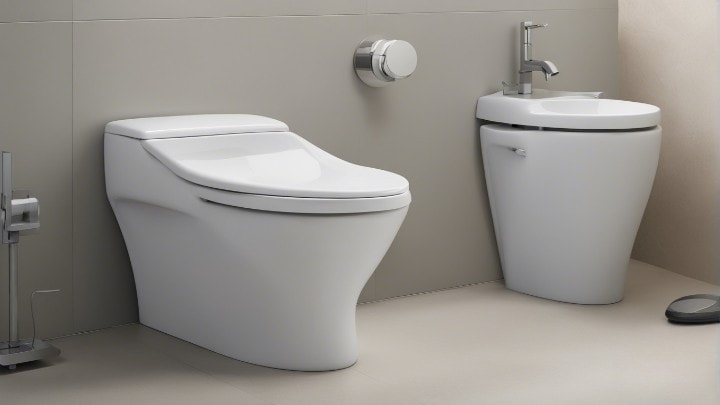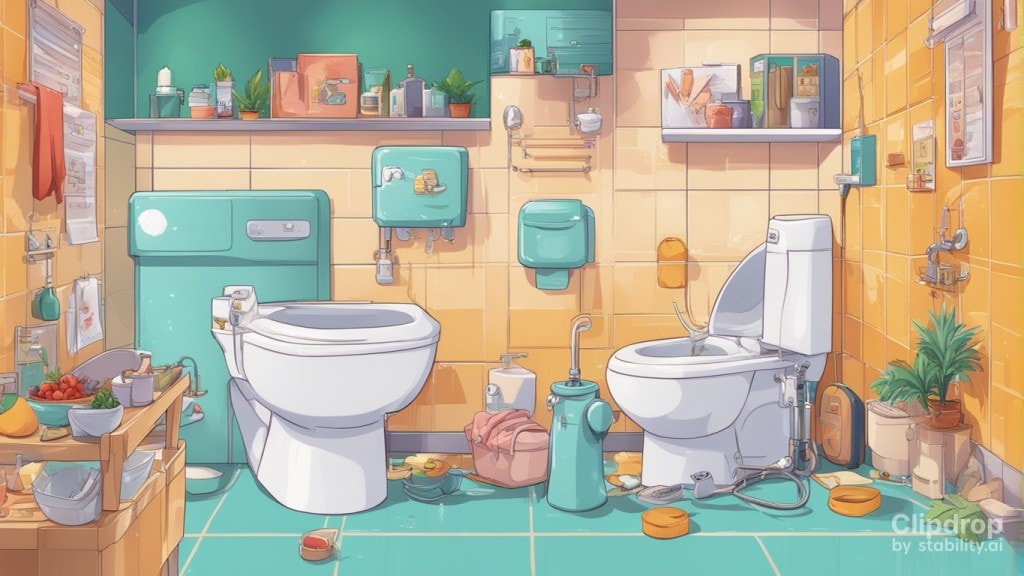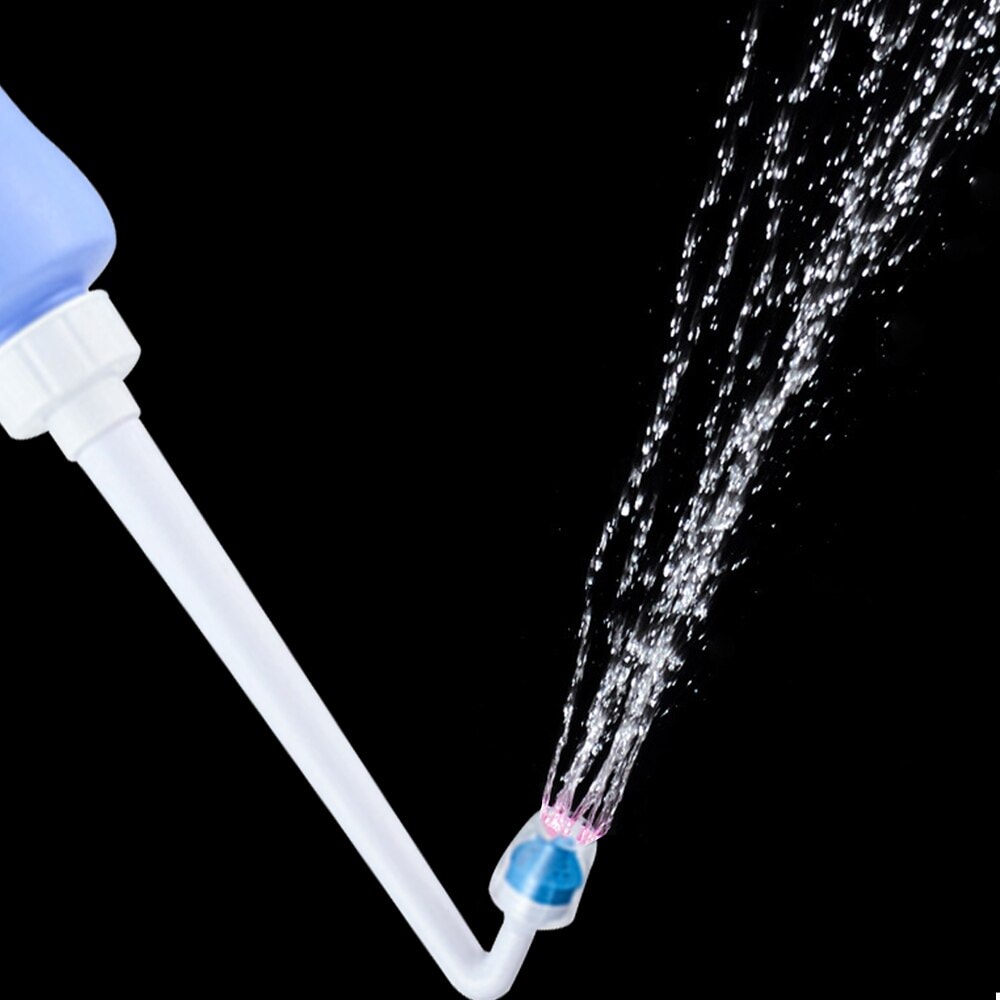Introducing “The Future of Hygiene: Can Bidets Outperform Toilet Paper?”
Are you tired of the never-ending cycle of toilet paper usage, wondering if there’s a better solution?
Imagine a world where cleanliness meets convenience, and bidets take center stage.
Bidets are not just a luxury item anymore; they might just revolutionize your bathroom routine.
Step into the future of hygiene as we explore the possibilities and implications of bidets replacing traditional toilet paper.
Discover the benefits, address the concerns, and uncover a whole new level of personal cleanliness.
Say goodbye to endless rolls and embrace a refreshing change.
Welcome to a cleaner, greener, and more comfortable future.
Table of Contents
Bidet Functionality
Bidets, once considered a luxury, are now making waves in the world of hygiene.
But how do they work?
And what types are available?
Let’s dive in.
How Bidets Work
Bidets are essentially bathroom fixtures designed to clean the user’s private areas using a stream of water.
Unlike the traditional method of wiping with toilet paper, bidets offer a hands-free, water-based cleaning method.
When activated, a nozzle releases a targeted stream of water, ensuring thorough cleaning.
This method not only reduces hand-to-poo contact but also minimizes post-poop residue, skid marks, and those pesky dingleberries.
Different Types of Bidets
There are several types of bidets available, each with its unique features and installation methods:
Standalone Bidets

These are separate fixtures installed next to the toilet.
They require users to move from the toilet to the bidet for cleaning.
Often seen in European bathrooms, they’re a classic choice for those who prioritize personal hygiene.
Bidet Attachments

These are added to your existing toilet, transforming it into a bidet.
They’re cost-effective and easy to install.
Bidet attachments are a popular choice for those looking to make sustainable choices without a complete bathroom overhaul.
Bidet Toilet Seats

Replacing your regular toilet seat, these come equipped with built-in nozzles.
They offer various features like adjustable water temperature, nozzle wash, and even air drying.
It’s a blend of comfort and functionality.
Portable Bidets

Compact and travel-friendly, these are perfect for those always on the move.
They work by manually squeezing a bottle, releasing a stream of water for cleaning.
Electric vs Non-Electric Bidets
While electric bidets offer features like warm water and air drying, non-electric ones are simpler and use the faucet supply or toilet water for cleaning.
Environmental Impact
Bidets, often perceived as luxury bathroom fixtures, are making a significant splash in the realm of sustainability.
When we talk about the environmental impact, it’s essential to consider both water usage and the broader ecological implications.
Water Usage: Bidets vs Toilet Paper Production
Bidets utilize a stream of water to cleanse, which might raise eyebrows about water consumption.
However, when we compare this with the water used in the production of toilet paper, the numbers tell a different story.
Producing a single roll of toilet paper requires approximately 37 gallons of water.
On the other hand, a typical bidet uses about 1/8th of a gallon per clean.
Over time, the water savings from bidet usage can be substantial.
Moreover, toilet paper production isn’t just about water.
It involves cutting down trees, energy consumption, and chemical processing.
Every year, millions of trees are chopped down to meet the global demand for toilet paper.
Switching to bidets can play a pivotal role in reducing this deforestation.
Broader Environmental Benefits of Bidets
Beyond water savings, bidets offer several other environmental advantages:
- Waste Reduction: Bidets can significantly reduce the amount of toilet paper waste ending up in landfills. With fewer trees being cut for toilet paper production, we can also expect a reduction in carbon emissions associated with deforestation.
- Chemical Processing: The bleaching and processing of toilet paper introduce harmful chemicals into the environment. Bidets eliminate the need for such processes, leading to a cleaner, more sustainable world.
- Toilet Clogs: Reduced toilet paper usage means fewer toilet clogs, leading to less strain on sewage systems and water treatment facilities.
- Zero-Waste Bathroom Rituals: Embracing bidets can be a step towards a zero-waste bathroom, aligning with sustainable choices and eco-friendly lifestyles.
Incorporating bidets into our bathroom habits can be a game-changer, not just for personal hygiene but also for the planet.
As we move towards more sustainable choices, bidets stand out as a cost-effective and environmentally friendly alternative to traditional toilet paper consumption.
Economic Considerations

When considering the shift from traditional toilet paper to bidets, it’s essential to weigh the economic implications.
Let’s delve into the cost dynamics of bidets versus long-term toilet paper usage and uncover hidden costs associated with toilet paper.
Cost of Bidets vs Long-Term Toilet Paper Usage
Bidets come in various types and price ranges.
From high-end electric bidet seats with multiple features to simple non-electric bidet attachments, the initial investment can range from $30 to over $600.
On the other hand, the average American spends about $120 annually on toilet paper.
Over a decade, that’s $1,200 on toilet paper alone!
Let’s break it down:
| Item | Initial Cost | Annual Cost | Cost Over 10 Years |
|---|---|---|---|
| Bidet (Average Cost) | $315 | $0 (No recurring cost) | $315 |
| Toilet Paper | $0 | $120 | $1,200 |
From the table, it’s evident that even with an average-priced bidet, the long-term savings are substantial.
Within three years, most bidet users recover their initial investment, and from then on, it’s pure savings.
Hidden Costs Associated with Toilet Paper
While the direct cost of toilet paper is evident in the numbers, there are several hidden costs:
- Environmental Impact: As discussed in the previous section, the environmental toll of toilet paper production is significant. Deforestation, water usage, and chemical processing have long-term ecological implications.
- Plumbing Issues: Excessive toilet paper usage can lead to clogs, requiring professional plumbing services. These unexpected expenses can add up over time.
- Health Costs: Irritation, rashes, and infections can result from toilet paper, especially if it’s of low quality. These health issues might lead to medical expenses and discomfort.
- Waste Management: Municipalities spend considerable amounts managing and processing waste, including toilet paper. These costs indirectly impact taxpayers.
In contrast, bidets offer a one-time investment with minimal maintenance costs.
They’re not just cost-effective but also environmentally friendly, aligning with sustainable choices and eco-friendly lifestyles.
Hygiene & Health
Bidets, often seen as a luxury or an unfamiliar bathroom fixture, have been gaining traction for their undeniable health and hygiene benefits.
Let’s delve deeper into how effective bidets truly are and the health advantages they offer.
Effectiveness of Bidets in Cleaning
Bidets provide a thorough cleaning experience that is hard to match with traditional toilet paper.
Here’s why:
- Water-Based Cleaning: Water is universally recognized as the most effective cleaning agent. Bidets use a targeted stream of water to cleanse, ensuring that no residue is left behind. This method is far superior to dry wiping, which can often leave behind traces of fecal matter.
- Reduced Hand Contact: With bidets, there’s minimal hand-to-poo contact, reducing the chances of bacterial transmission. This is especially crucial in preventing the spread of gastrointestinal diseases caused by fecal-oral transmission.
- Post-Poop Cleanliness: Bidets ensure that post-poop residues, skid marks, and dingleberries are a thing of the past.
This level of cleanliness is hard to achieve with just toilet paper.
Health Benefits of Bidets
Bidets aren’t just about cleanliness; they offer several health advantages:
- Reduced Irritation: Continuous wiping with toilet paper can cause irritation, especially for those with sensitive skin. The gentle water stream from bidets can prevent such irritations and provide relief.
- Beneficial for Specific Conditions: For individuals with conditions like hemorrhoids, anal fissures, or post-surgical stitches, bidets can be a godsend. The water-based cleaning is gentle and doesn’t aggravate the condition, unlike rough toilet paper.
- Prevention of UTIs: For women, bidets can help in preventing urinary tract infections (UTIs). By ensuring thorough cleaning, bidets reduce the chances of bacterial transmission from the anal region to the urethra.
- Eco-Friendly Personal Hygiene: With the environmental impact of toilet paper production and waste, bidets offer a sustainable choice for personal hygiene. They align with zero-waste bathroom rituals, promoting both personal and environmental health.
- Enhanced Personal Comfort: Many people find the experience of using a bidet more comfortable and refreshing than using toilet paper. It’s like a mini-shower for your nether regions, ensuring you feel clean and refreshed after every bathroom visit.
Misconceptions & Myths
Bidets, despite their growing popularity and undeniable benefits, are often surrounded by myths and misconceptions.
Let’s address some of these common misunderstandings and set the record straight.
Myth: Bidets are a Luxury Item
Fact: While bidets were once seen as a luxury, they are now accessible and affordable for many.
With various types available, from bidet attachments to standalone units, there’s a bidet for every budget.
They’re not just for the elite; they’re for everyone who values personal hygiene and environmental sustainability.
Myth: Bidets are Unsanitary
Fact: Contrary to this belief, bidets offer a more hygienic cleaning method than toilet paper.
The water-based cleaning ensures thorough removal of fecal matter, reducing the risk of bacterial transmission.
Plus, with minimal hand-to-poo contact, bidets promote better hand hygiene.
Myth: Bidets Waste Water
Fact: While bidets do use water, they are more water-efficient than the production of toilet paper.
As highlighted earlier, producing a single roll of toilet paper requires approximately 37 gallons of water, whereas a bidet uses about 1/8th of a gallon per clean.
Over time, bidets prove to be a more sustainable choice in terms of water usage.
Myth: Bidets are Hard to Install
Fact: Installation varies based on the type of bidet, but many modern bidets, especially bidet attachments, are designed for easy DIY installation.
You don’t need to be a plumbing expert to add a bidet to your bathroom rituals.
Myth: Bidets are Only for Women
Fact: Bidets are for everyone!
Men, women, and children can all benefit from the enhanced cleanliness and comfort that bidets offer.
They’re especially beneficial for individuals with specific conditions like hemorrhoids or post-surgical stitches.
Myth: Using a Bidet is Uncomfortable
Fact: Most people find the bidet experience refreshing and comfortable.
It’s like a mini-shower for your nether regions.
With adjustable water temperature and pressure in many models, you can customize the experience to your liking.
Myth: Bidets are Not Eco-Friendly
Fact: Bidets are a step towards a zero-waste bathroom.
They reduce toilet paper consumption, leading to fewer trees being cut and less waste ending up in landfills.
As discussed earlier, bidets have a lower environmental impact in terms of water usage and carbon emissions compared to toilet paper.
Myth: You Still Need Toilet Paper with a Bidet
Fact: While some people might use a small amount of toilet paper to pat dry after using a bidet, the amount is significantly less than what would be used without a bidet.
Many bidets also come with air dryers, eliminating the need for toilet paper altogether.
Myth: Bidets are a New Trend
Fact: Bidets have been around for centuries and are standard fixtures in many countries around the world.
Their recent surge in popularity in certain regions is due to increased awareness of their benefits and sustainability.
Myth: Bidets are Expensive in the Long Run
Fact: While there’s an initial investment, bidets prove to be cost-effective in the long run.
As highlighted in the economic considerations section, the long-term savings from reduced toilet paper consumption make bidets a financially sound choice.
Future Trends
As the world continues to evolve, so do our bathroom fixtures.
The bidet, once a luxury item in many parts of the world, is now at the forefront of technological advancements and global adoption.
Let’s take a closer look at what the future holds for bidets and their potential to outperform toilet paper.
Technological Advancements in Bidets
Bidets are no longer just about a stream of water.
With the integration of technology, they are becoming smarter and more efficient:
- Smart Bidets: Just like smart toilets, bidets are now equipped with sensors that can adjust the water temperature and pressure based on user preferences. Some even come with self-cleaning features, ensuring optimal hygiene.
- Eco-Friendly Features: As sustainability becomes a priority, bidets are being designed to use minimal water without compromising on cleanliness. Some models now have eco modes that reduce water usage even further.
- Customizable Experience: Advanced bidets offer a range of customization options, from oscillating water streams to adjustable nozzle positions, ensuring a comfortable experience for every user.
- Integration with Smart Home Systems: Imagine controlling your bidet with voice commands or having it sync with your smart home system.
This isn’t a distant dream but a reality with some of the latest bidet models.
Predictions for Global Adoption
The global adoption of bidets is on the rise, and here’s what experts predict for the future:
- Increased Awareness and Education: As more people become aware of the hygiene and environmental benefits of bidets, their adoption is expected to surge. Educational campaigns and initiatives by bidet brands will play a crucial role in this.
- Affordability: As production scales up and technology becomes more accessible, the cost of advanced bidets is expected to decrease, making them affordable for a larger segment of the population.
- Regulations and Incentives: Some regions might introduce regulations promoting the use of bidets to reduce toilet paper waste. Additionally, incentives or tax breaks for eco-friendly bathroom fixtures could further boost bidet adoption.
- Cultural Shifts: While some cultures have been slow to adopt bidets, changing global travel patterns and increased exposure to different bathroom rituals might lead to a shift in perceptions and preferences.
- Innovation in Design: As bidets become mainstream, we can expect to see more innovative designs that not only enhance functionality but also aesthetics.
Bidets will no longer be an afterthought but an integral part of bathroom design.
Final Say So!
In a world where sustainability and personal hygiene are paramount, bidets emerge as the unsung heroes of the bathroom.
No longer confined to the realms of luxury, they present a compelling case against the age-old toilet paper.
With their undeniable environmental, economic, and health benefits, coupled with technological advancements, bidets are not just the future; they are the now.
So, as we stand at the crossroads of tradition and innovation, it’s time to ask ourselves: Why hold onto rolls when we can embrace the revolution?
Say hello to bidets, the future of hygiene, and wave goodbye to the outdated, wasteful ways of toilet paper.
The future is clean, green, and refreshingly bidet-centric!
FAQs
Is a bidet more sanitary than wiping?
Yes, bidets are considered more sanitary than wiping as they use water to cleanse the area, reducing the risk of spreading bacteria.
Do people still wipe after using bidet?
Some people do choose to wipe after using a bidet to dry off, but it’s not necessary if the bidet has a drying function.
Do you dry with toilet paper after using a bidet?
Yes, many people dry with toilet paper after using a bidet, especially if the bidet doesn’t have a drying function. However, some bidets come with air dryers, eliminating the need for toilet paper.
Is bidet safer than toilet paper?
Yes, bidets can be safer than toilet paper in terms of hygiene as they reduce the physical contact and potential spread of bacteria. They also reduce the risk of irritation caused by wiping.
How much cleaner is a bidet than toilet paper?
A bidet is generally considered cleaner than toilet paper because it uses water to wash away contaminants, providing a more thorough cleanse.
Are bidets better for the environment than toilet paper?
Yes, bidets are better for the environment than toilet paper. They reduce the need for paper production, which saves trees and water, and decreases the amount of waste in landfills.


